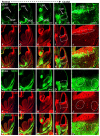COUP-TFII controls amygdala patterning by regulating neuropilin expression
- PMID: 22492355
- PMCID: PMC3317968
- DOI: 10.1242/dev.075564
COUP-TFII controls amygdala patterning by regulating neuropilin expression
Abstract
The development of the progenitor zones in the pallium, lateral ganglionic eminence (LGE) and medial ganglionic eminence (MGE) in the subpallium has been well studied; however, so far the role of the caudal ganglionic eminence (CGE), a posterior subpallial domain, in telencephalon patterning remains poorly understood. COUP-TFII, an orphan nuclear receptor, is preferentially expressed in the CGE. We generated COUP-TFII mouse mutants, using Rx-Cre (RxCre;COUP-TFII(F/F)), to study its function in telencephalon development. In these mutants, we found severe defects in the formation of the amygdala complex, including the lateral (LA), basolateral (BLA) and basomedial (BMA) amygdala nuclei. Molecular analysis provided evidence that the migration of CGE-derived Pax6(+) cells failed to settle into the BMA nucleus, owing to reduced expression of neuropilin 1 (Nrp1) and Nrp2, two semaphorin receptors that regulate neuronal cell migration and axon guidance. Our ChIP assays revealed that Nrp1 and Nrp2 genes are the direct targets of COUP-TFII in the telencephalon in vivo. Furthermore, our results showed that the coordinated development between the CGE originated subpallial population (Pax6(+) cells) and pallial populations (Tbr1(+) and Lhx2(+) cells) was essential for patterning the amygdala assembly. Our study presented novel genetic evidence that the caudal ganglionic eminence, a distinct subpallial progenitor zone, contributes cells to the basal telencephalon, such as the BMA nucleus.
Figures







Similar articles
-
Nuclear receptor COUP-TFII-expressing neocortical interneurons are derived from the medial and lateral/caudal ganglionic eminence and define specific subsets of mature interneurons.J Comp Neurol. 2013 Feb 1;521(2):479-97. doi: 10.1002/cne.23186. J Comp Neurol. 2013. PMID: 22791192
-
The COUP-TFII/Neuropilin-2 is a molecular switch steering diencephalon-derived GABAergic neurons in the developing mouse brain.Proc Natl Acad Sci U S A. 2015 Sep 8;112(36):E4985-94. doi: 10.1073/pnas.1420701112. Epub 2015 Aug 24. Proc Natl Acad Sci U S A. 2015. PMID: 26305926 Free PMC article.
-
The Transcription Factors COUP-TFI and COUP-TFII have Distinct Roles in Arealisation and GABAergic Interneuron Specification in the Early Human Fetal Telencephalon.Cereb Cortex. 2017 Oct 1;27(10):4971-4987. doi: 10.1093/cercor/bhx185. Cereb Cortex. 2017. PMID: 28922831 Free PMC article.
-
Transcriptional Regulation of Cortical Interneuron Development.In: Noebels JL, Avoli M, Rogawski MA, Vezzani A, Delgado-Escueta AV, editors. Jasper's Basic Mechanisms of the Epilepsies. 5th edition. New York: Oxford University Press; 2024. Chapter 47. In: Noebels JL, Avoli M, Rogawski MA, Vezzani A, Delgado-Escueta AV, editors. Jasper's Basic Mechanisms of the Epilepsies. 5th edition. New York: Oxford University Press; 2024. Chapter 47. PMID: 39637134 Free Books & Documents. Review.
-
COUP-TFII revisited: Its role in metabolic gene regulation.Steroids. 2019 Jan;141:63-69. doi: 10.1016/j.steroids.2018.11.013. Epub 2018 Nov 24. Steroids. 2019. PMID: 30481528 Free PMC article. Review.
Cited by
-
Atrial identity is determined by a COUP-TFII regulatory network.Dev Cell. 2013 May 28;25(4):417-26. doi: 10.1016/j.devcel.2013.04.017. Dev Cell. 2013. PMID: 23725765 Free PMC article.
-
International Union of Basic and Clinical Pharmacology CXIII: Nuclear Receptor Superfamily-Update 2023.Pharmacol Rev. 2023 Nov;75(6):1233-1318. doi: 10.1124/pharmrev.121.000436. Epub 2023 Aug 16. Pharmacol Rev. 2023. PMID: 37586884 Free PMC article. Review.
-
Genotyping-By-Sequencing (GBS) Detects Genetic Structure and Confirms Behavioral QTL in Tame and Aggressive Foxes (Vulpes vulpes).PLoS One. 2015 Jun 10;10(6):e0127013. doi: 10.1371/journal.pone.0127013. eCollection 2015. PLoS One. 2015. PMID: 26061395 Free PMC article.
-
Characterization of the TBR1 interactome: variants associated with neurodevelopmental disorders disrupt novel protein interactions.Hum Mol Genet. 2023 Apr 20;32(9):1497-1510. doi: 10.1093/hmg/ddac311. Hum Mol Genet. 2023. PMID: 36579832 Free PMC article.
-
Fibroblast growth factor receptor 1 signaling transcriptionally regulates the axon guidance cue slit1.Cell Mol Life Sci. 2018 Oct;75(19):3649-3661. doi: 10.1007/s00018-018-2824-x. Epub 2018 Apr 28. Cell Mol Life Sci. 2018. PMID: 29705951 Free PMC article.
References
-
- Bulchand S., Grove E. A., Porter F. D., Tole S. (2001). LIM-homeodomain gene Lhx2 regulates the formation of the cortical hem. Mech. Dev. 100, 165–175 - PubMed
-
- Bulfone A., Smiga S. M., Shimamura K., Peterson A., Puelles L., Rubenstein J. L. (1995). T-brain-1: a homolog of Brachyury whose expression defines molecularly distinct domains within the cerebral cortex. Neuron 15, 63–78 - PubMed
-
- Bupesh M., Legaz I., Antonio Abellán A., Medina L. (2011a). Multiple telencephalic and extratelencephalic embryonic domains contribute neurons to the medial extended amygdala. J. Comp. Neurol. 519, 1505–1525 - PubMed
-
- Bupesh M., Abellán A., Medina L. (2011b). Genetic and experimental evidence supports the continuum of the central extended amygdala and a mutiple embryonic origin of its principal neurons. J. Comp. Neurol. 519, 3507–3531 - PubMed
-
- Butt S. J., Fuccillo M., Nery S., Noctor S., Kriegstein A., Corbin J. G., Fishell G. (2005). The temporal and spatial origins of cortical interneurons predict their physiological subtype. Neuron 48, 591–604 - PubMed
Publication types
MeSH terms
Substances
Grants and funding
- R37 HD017379/HD/NICHD NIH HHS/United States
- HD17379/HD/NICHD NIH HHS/United States
- P01 DK059820/DK/NIDDK NIH HHS/United States
- R01 DK045641/DK/NIDDK NIH HHS/United States
- U19 DK062434/DK/NIDDK NIH HHS/United States
- R01 HD017379/HD/NICHD NIH HHS/United States
- R37 DK045641/DK/NIDDK NIH HHS/United States
- DK079638/DK/NIDDK NIH HHS/United States
- R01 NS099099/NS/NINDS NIH HHS/United States
- DK59820/DK/NIDDK NIH HHS/United States
- HL76448/HL/NHLBI NIH HHS/United States
- DK45641/DK/NIDDK NIH HHS/United States
- R01 HL076448/HL/NHLBI NIH HHS/United States
- R01 NS034661/NS/NINDS NIH HHS/United States
- DK62434/DK/NIDDK NIH HHS/United States
- P30 DK079638/DK/NIDDK NIH HHS/United States
LinkOut - more resources
Full Text Sources
Molecular Biology Databases
Miscellaneous

